BTEC Unit 32 Food Retailing: Analyzing Size, Structure, and Impact
VerifiedAdded on 2023/06/30
|18
|4884
|91
Report
AI Summary
This report provides a comprehensive analysis of the UK food retailing sector, focusing on its size, structure, and the impact of consumer market developments. It begins by describing the various components of the food retail sector, including superstores, co-operatives, farmer's markets, e-traders, hypermarkets, convenience stores, and specialty stores. The report then examines the market size and share, noting the significant contribution of the food and drink retail sector to the UK economy in terms of revenue and job creation. Furthermore, it describes the types of products offered by different food retailers, such as Tesco, Winchester Farmers’ market, and Edinburgh Farmers' Market, highlighting the variety and sourcing strategies. Finally, the report explains the impacts of consumer market development on food retailing, including customer expectations, higher consumer spending, cultural and lifestyle expectations, increased mobility, technological developments, seasonal changes, and environmental attitudes. The report concludes by emphasizing the importance of adapting to evolving consumer demands and maintaining ethical and environmental responsibilities within the food retail sector.
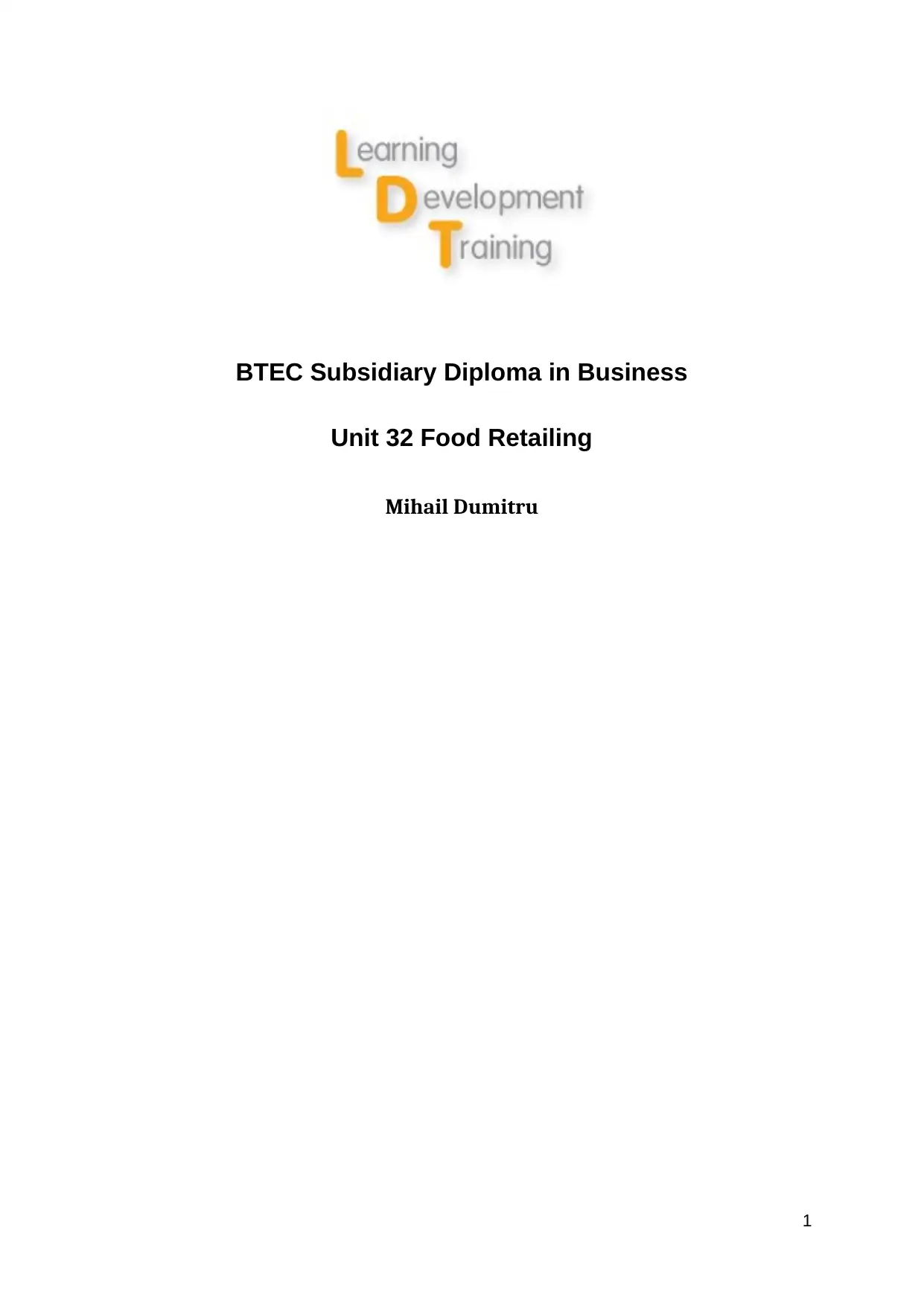
BTEC Subsidiary Diploma in Business
Unit 32 Food Retailing
Mihail Dumitru
1
Unit 32 Food Retailing
Mihail Dumitru
1
Paraphrase This Document
Need a fresh take? Get an instant paraphrase of this document with our AI Paraphraser
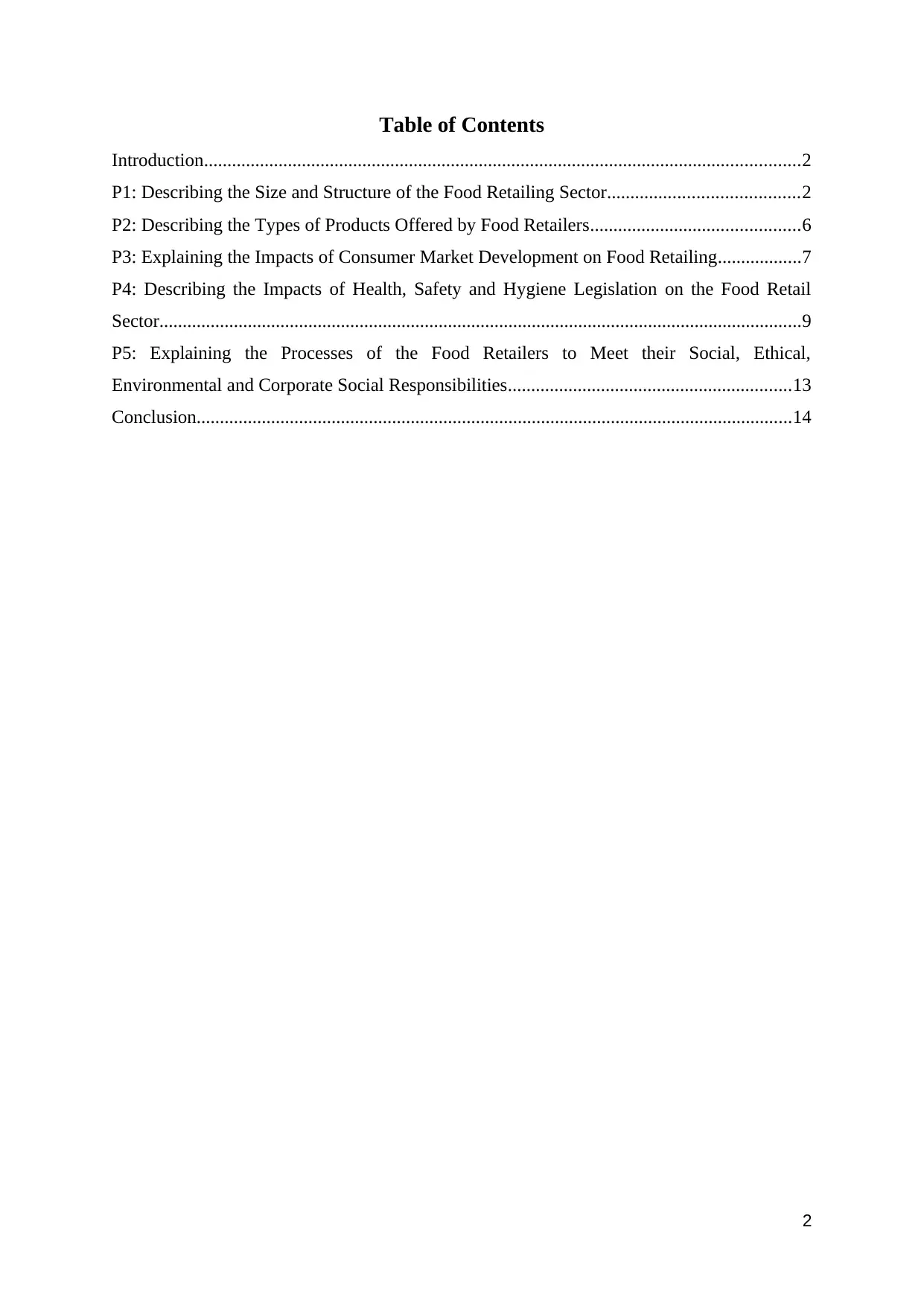
Table of Contents
Introduction................................................................................................................................2
P1: Describing the Size and Structure of the Food Retailing Sector.........................................2
P2: Describing the Types of Products Offered by Food Retailers.............................................6
P3: Explaining the Impacts of Consumer Market Development on Food Retailing..................7
P4: Describing the Impacts of Health, Safety and Hygiene Legislation on the Food Retail
Sector..........................................................................................................................................9
P5: Explaining the Processes of the Food Retailers to Meet their Social, Ethical,
Environmental and Corporate Social Responsibilities.............................................................13
Conclusion................................................................................................................................14
2
Introduction................................................................................................................................2
P1: Describing the Size and Structure of the Food Retailing Sector.........................................2
P2: Describing the Types of Products Offered by Food Retailers.............................................6
P3: Explaining the Impacts of Consumer Market Development on Food Retailing..................7
P4: Describing the Impacts of Health, Safety and Hygiene Legislation on the Food Retail
Sector..........................................................................................................................................9
P5: Explaining the Processes of the Food Retailers to Meet their Social, Ethical,
Environmental and Corporate Social Responsibilities.............................................................13
Conclusion................................................................................................................................14
2
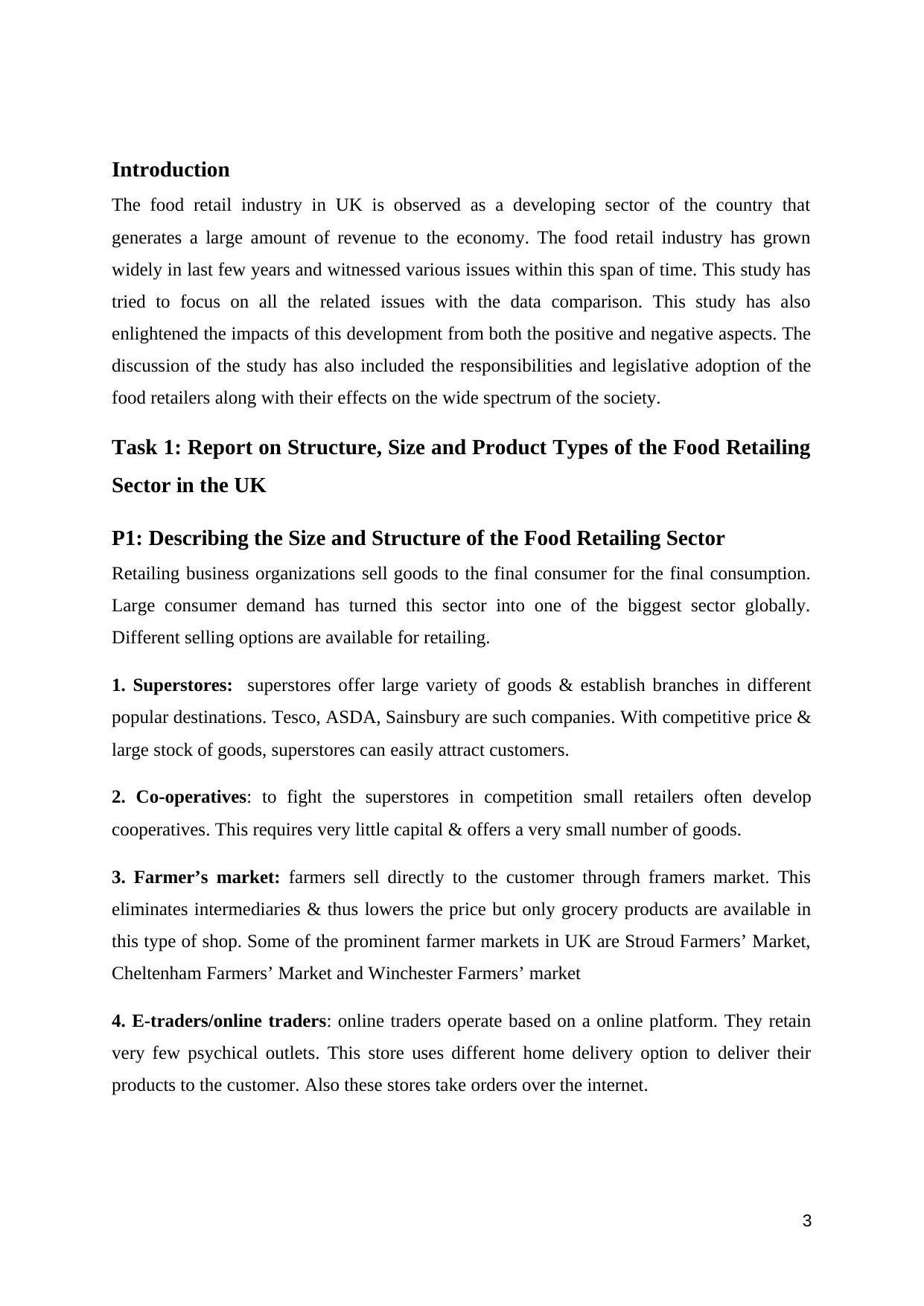
Introduction
The food retail industry in UK is observed as a developing sector of the country that
generates a large amount of revenue to the economy. The food retail industry has grown
widely in last few years and witnessed various issues within this span of time. This study has
tried to focus on all the related issues with the data comparison. This study has also
enlightened the impacts of this development from both the positive and negative aspects. The
discussion of the study has also included the responsibilities and legislative adoption of the
food retailers along with their effects on the wide spectrum of the society.
Task 1: Report on Structure, Size and Product Types of the Food Retailing
Sector in the UK
P1: Describing the Size and Structure of the Food Retailing Sector
Retailing business organizations sell goods to the final consumer for the final consumption.
Large consumer demand has turned this sector into one of the biggest sector globally.
Different selling options are available for retailing.
1. Superstores: superstores offer large variety of goods & establish branches in different
popular destinations. Tesco, ASDA, Sainsbury are such companies. With competitive price &
large stock of goods, superstores can easily attract customers.
2. Co-operatives: to fight the superstores in competition small retailers often develop
cooperatives. This requires very little capital & offers a very small number of goods.
3. Farmer’s market: farmers sell directly to the customer through framers market. This
eliminates intermediaries & thus lowers the price but only grocery products are available in
this type of shop. Some of the prominent farmer markets in UK are Stroud Farmers’ Market,
Cheltenham Farmers’ Market and Winchester Farmers’ market
4. E-traders/online traders: online traders operate based on a online platform. They retain
very few psychical outlets. This store uses different home delivery option to deliver their
products to the customer. Also these stores take orders over the internet.
3
The food retail industry in UK is observed as a developing sector of the country that
generates a large amount of revenue to the economy. The food retail industry has grown
widely in last few years and witnessed various issues within this span of time. This study has
tried to focus on all the related issues with the data comparison. This study has also
enlightened the impacts of this development from both the positive and negative aspects. The
discussion of the study has also included the responsibilities and legislative adoption of the
food retailers along with their effects on the wide spectrum of the society.
Task 1: Report on Structure, Size and Product Types of the Food Retailing
Sector in the UK
P1: Describing the Size and Structure of the Food Retailing Sector
Retailing business organizations sell goods to the final consumer for the final consumption.
Large consumer demand has turned this sector into one of the biggest sector globally.
Different selling options are available for retailing.
1. Superstores: superstores offer large variety of goods & establish branches in different
popular destinations. Tesco, ASDA, Sainsbury are such companies. With competitive price &
large stock of goods, superstores can easily attract customers.
2. Co-operatives: to fight the superstores in competition small retailers often develop
cooperatives. This requires very little capital & offers a very small number of goods.
3. Farmer’s market: farmers sell directly to the customer through framers market. This
eliminates intermediaries & thus lowers the price but only grocery products are available in
this type of shop. Some of the prominent farmer markets in UK are Stroud Farmers’ Market,
Cheltenham Farmers’ Market and Winchester Farmers’ market
4. E-traders/online traders: online traders operate based on a online platform. They retain
very few psychical outlets. This store uses different home delivery option to deliver their
products to the customer. Also these stores take orders over the internet.
3
⊘ This is a preview!⊘
Do you want full access?
Subscribe today to unlock all pages.

Trusted by 1+ million students worldwide
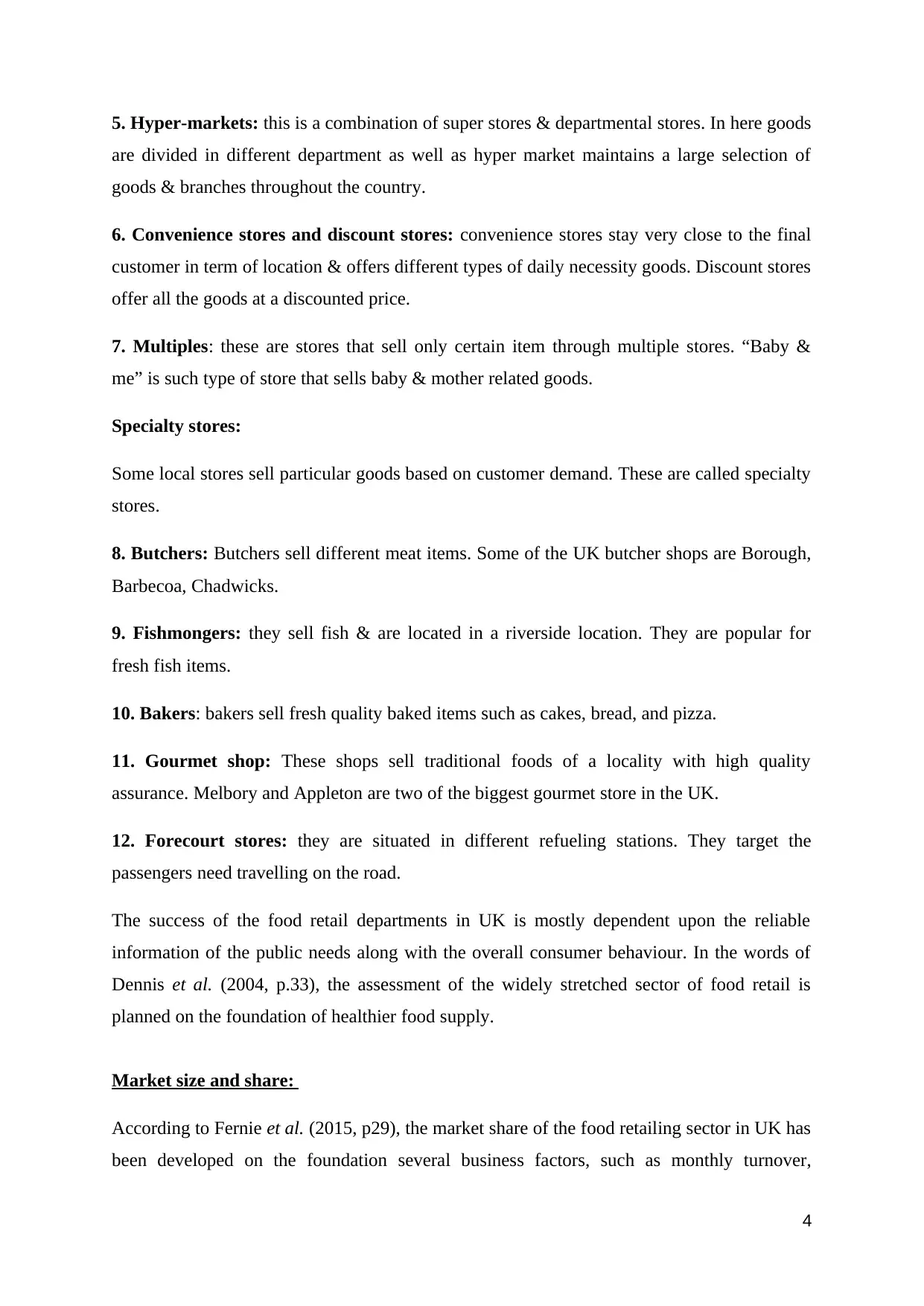
5. Hyper-markets: this is a combination of super stores & departmental stores. In here goods
are divided in different department as well as hyper market maintains a large selection of
goods & branches throughout the country.
6. Convenience stores and discount stores: convenience stores stay very close to the final
customer in term of location & offers different types of daily necessity goods. Discount stores
offer all the goods at a discounted price.
7. Multiples: these are stores that sell only certain item through multiple stores. “Baby &
me” is such type of store that sells baby & mother related goods.
Specialty stores:
Some local stores sell particular goods based on customer demand. These are called specialty
stores.
8. Butchers: Butchers sell different meat items. Some of the UK butcher shops are Borough,
Barbecoa, Chadwicks.
9. Fishmongers: they sell fish & are located in a riverside location. They are popular for
fresh fish items.
10. Bakers: bakers sell fresh quality baked items such as cakes, bread, and pizza.
11. Gourmet shop: These shops sell traditional foods of a locality with high quality
assurance. Melbory and Appleton are two of the biggest gourmet store in the UK.
12. Forecourt stores: they are situated in different refueling stations. They target the
passengers need travelling on the road.
The success of the food retail departments in UK is mostly dependent upon the reliable
information of the public needs along with the overall consumer behaviour. In the words of
Dennis et al. (2004, p.33), the assessment of the widely stretched sector of food retail is
planned on the foundation of healthier food supply.
Market size and share:
According to Fernie et al. (2015, p29), the market share of the food retailing sector in UK has
been developed on the foundation several business factors, such as monthly turnover,
4
are divided in different department as well as hyper market maintains a large selection of
goods & branches throughout the country.
6. Convenience stores and discount stores: convenience stores stay very close to the final
customer in term of location & offers different types of daily necessity goods. Discount stores
offer all the goods at a discounted price.
7. Multiples: these are stores that sell only certain item through multiple stores. “Baby &
me” is such type of store that sells baby & mother related goods.
Specialty stores:
Some local stores sell particular goods based on customer demand. These are called specialty
stores.
8. Butchers: Butchers sell different meat items. Some of the UK butcher shops are Borough,
Barbecoa, Chadwicks.
9. Fishmongers: they sell fish & are located in a riverside location. They are popular for
fresh fish items.
10. Bakers: bakers sell fresh quality baked items such as cakes, bread, and pizza.
11. Gourmet shop: These shops sell traditional foods of a locality with high quality
assurance. Melbory and Appleton are two of the biggest gourmet store in the UK.
12. Forecourt stores: they are situated in different refueling stations. They target the
passengers need travelling on the road.
The success of the food retail departments in UK is mostly dependent upon the reliable
information of the public needs along with the overall consumer behaviour. In the words of
Dennis et al. (2004, p.33), the assessment of the widely stretched sector of food retail is
planned on the foundation of healthier food supply.
Market size and share:
According to Fernie et al. (2015, p29), the market share of the food retailing sector in UK has
been developed on the foundation several business factors, such as monthly turnover,
4
Paraphrase This Document
Need a fresh take? Get an instant paraphrase of this document with our AI Paraphraser

numbers of the outlets, annual sales, numbers of the customers, numbers of the employees
and the statistics of sales. All these factors are usually recognised as the utility factors in the
size of the overall food retailing sector. In most of the cases, the summation of all these
factors is recognised as the total size of the food retail sector in UK. They are often found
collaborated with some other beneficial factors, which are mostly related with the consumer
growth. The sudden changes in the consumer behaviours or any sort of switch-attention
incidents are potential to change the size of the entire sector of food retail.
The structure of the food retailing sector is considered as another major tool in UK. It is one
of the superior most key factors to definite the growth of the food retailing business in all
over UK. In the words of Freathy (2003, p.41), food retailing sector in UK is stretched up to a
wide spectrum and developed with numbers of outlets. Most of the businesses in this sector
are structured with the formations of outlet.
In 2015, consumption of food, drink & catering soar to 205 billion GBP. Only food & drink
retailer added a value of around GBP 20 billion. At the same time 54000 companies created
almost 1157000 jobs in the UK economy. Food & drinks retailer consists of the GBP 30
billion in the UK market share in 2014 (Fernie and Sparks, 2015).
Figure 1: Grocery Market Shares for 2015 (Fernie and Sparks, 2015)
5
and the statistics of sales. All these factors are usually recognised as the utility factors in the
size of the overall food retailing sector. In most of the cases, the summation of all these
factors is recognised as the total size of the food retail sector in UK. They are often found
collaborated with some other beneficial factors, which are mostly related with the consumer
growth. The sudden changes in the consumer behaviours or any sort of switch-attention
incidents are potential to change the size of the entire sector of food retail.
The structure of the food retailing sector is considered as another major tool in UK. It is one
of the superior most key factors to definite the growth of the food retailing business in all
over UK. In the words of Freathy (2003, p.41), food retailing sector in UK is stretched up to a
wide spectrum and developed with numbers of outlets. Most of the businesses in this sector
are structured with the formations of outlet.
In 2015, consumption of food, drink & catering soar to 205 billion GBP. Only food & drink
retailer added a value of around GBP 20 billion. At the same time 54000 companies created
almost 1157000 jobs in the UK economy. Food & drinks retailer consists of the GBP 30
billion in the UK market share in 2014 (Fernie and Sparks, 2015).
Figure 1: Grocery Market Shares for 2015 (Fernie and Sparks, 2015)
5

In March 2015 UK grocery industry experienced a 1.7% increase from 2014 & valued as
GBP 177.5 billion. Cost for grocery accounted for 9% of the total cost & it has emerged as
the 3rd largest expenditure after housing & transport. Around 85000 retailer have been
registered in 2015-2016 & this excludes differ online retailer which also consists a large
portion of the industry.
6
GBP 177.5 billion. Cost for grocery accounted for 9% of the total cost & it has emerged as
the 3rd largest expenditure after housing & transport. Around 85000 retailer have been
registered in 2015-2016 & this excludes differ online retailer which also consists a large
portion of the industry.
6
⊘ This is a preview!⊘
Do you want full access?
Subscribe today to unlock all pages.

Trusted by 1+ million students worldwide
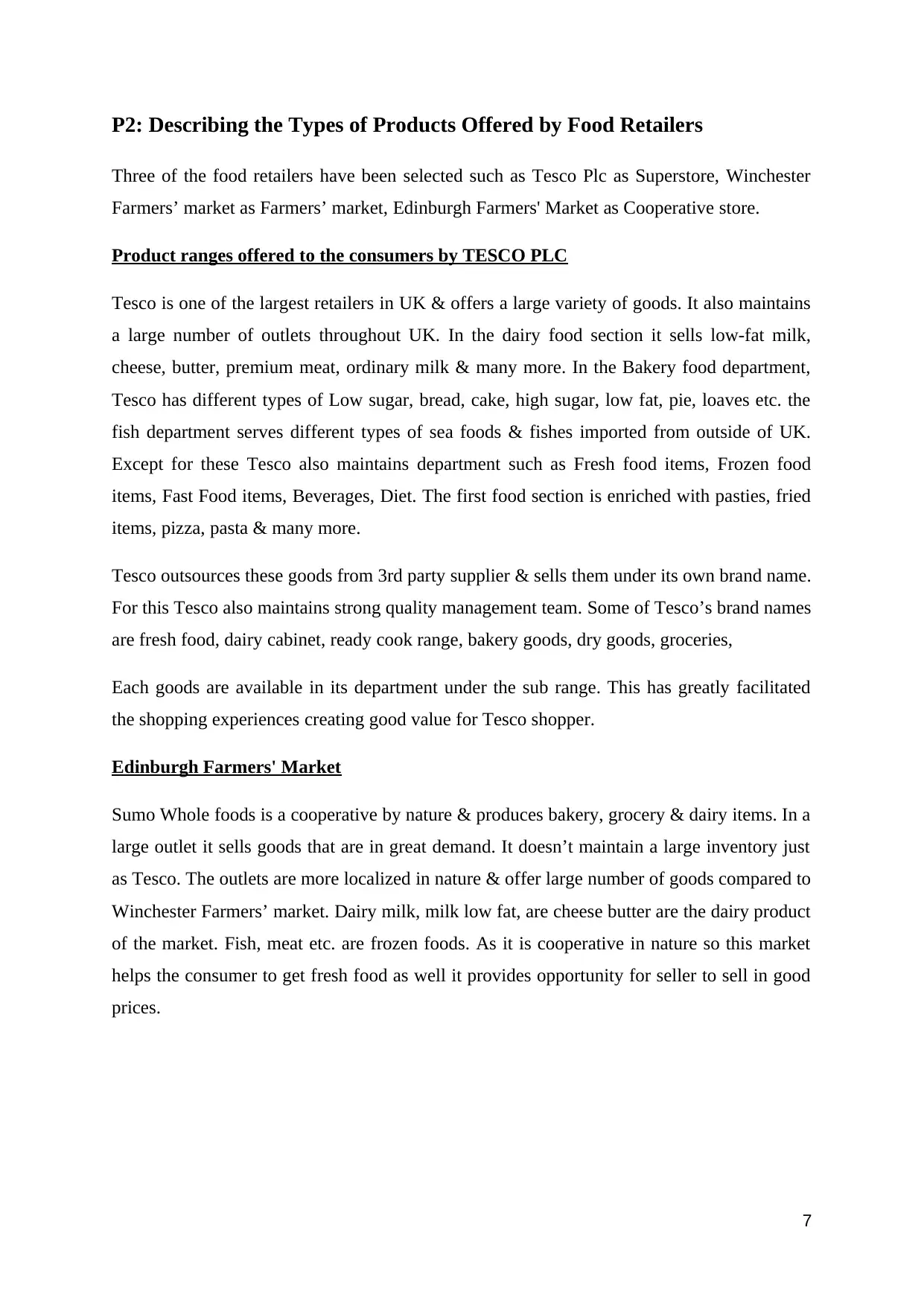
P2: Describing the Types of Products Offered by Food Retailers
Three of the food retailers have been selected such as Tesco Plc as Superstore, Winchester
Farmers’ market as Farmers’ market, Edinburgh Farmers' Market as Cooperative store.
Product ranges offered to the consumers by TESCO PLC
Tesco is one of the largest retailers in UK & offers a large variety of goods. It also maintains
a large number of outlets throughout UK. In the dairy food section it sells low-fat milk,
cheese, butter, premium meat, ordinary milk & many more. In the Bakery food department,
Tesco has different types of Low sugar, bread, cake, high sugar, low fat, pie, loaves etc. the
fish department serves different types of sea foods & fishes imported from outside of UK.
Except for these Tesco also maintains department such as Fresh food items, Frozen food
items, Fast Food items, Beverages, Diet. The first food section is enriched with pasties, fried
items, pizza, pasta & many more.
Tesco outsources these goods from 3rd party supplier & sells them under its own brand name.
For this Tesco also maintains strong quality management team. Some of Tesco’s brand names
are fresh food, dairy cabinet, ready cook range, bakery goods, dry goods, groceries,
Each goods are available in its department under the sub range. This has greatly facilitated
the shopping experiences creating good value for Tesco shopper.
Edinburgh Farmers' Market
Sumo Whole foods is a cooperative by nature & produces bakery, grocery & dairy items. In a
large outlet it sells goods that are in great demand. It doesn’t maintain a large inventory just
as Tesco. The outlets are more localized in nature & offer large number of goods compared to
Winchester Farmers’ market. Dairy milk, milk low fat, are cheese butter are the dairy product
of the market. Fish, meat etc. are frozen foods. As it is cooperative in nature so this market
helps the consumer to get fresh food as well it provides opportunity for seller to sell in good
prices.
7
Three of the food retailers have been selected such as Tesco Plc as Superstore, Winchester
Farmers’ market as Farmers’ market, Edinburgh Farmers' Market as Cooperative store.
Product ranges offered to the consumers by TESCO PLC
Tesco is one of the largest retailers in UK & offers a large variety of goods. It also maintains
a large number of outlets throughout UK. In the dairy food section it sells low-fat milk,
cheese, butter, premium meat, ordinary milk & many more. In the Bakery food department,
Tesco has different types of Low sugar, bread, cake, high sugar, low fat, pie, loaves etc. the
fish department serves different types of sea foods & fishes imported from outside of UK.
Except for these Tesco also maintains department such as Fresh food items, Frozen food
items, Fast Food items, Beverages, Diet. The first food section is enriched with pasties, fried
items, pizza, pasta & many more.
Tesco outsources these goods from 3rd party supplier & sells them under its own brand name.
For this Tesco also maintains strong quality management team. Some of Tesco’s brand names
are fresh food, dairy cabinet, ready cook range, bakery goods, dry goods, groceries,
Each goods are available in its department under the sub range. This has greatly facilitated
the shopping experiences creating good value for Tesco shopper.
Edinburgh Farmers' Market
Sumo Whole foods is a cooperative by nature & produces bakery, grocery & dairy items. In a
large outlet it sells goods that are in great demand. It doesn’t maintain a large inventory just
as Tesco. The outlets are more localized in nature & offer large number of goods compared to
Winchester Farmers’ market. Dairy milk, milk low fat, are cheese butter are the dairy product
of the market. Fish, meat etc. are frozen foods. As it is cooperative in nature so this market
helps the consumer to get fresh food as well it provides opportunity for seller to sell in good
prices.
7
Paraphrase This Document
Need a fresh take? Get an instant paraphrase of this document with our AI Paraphraser
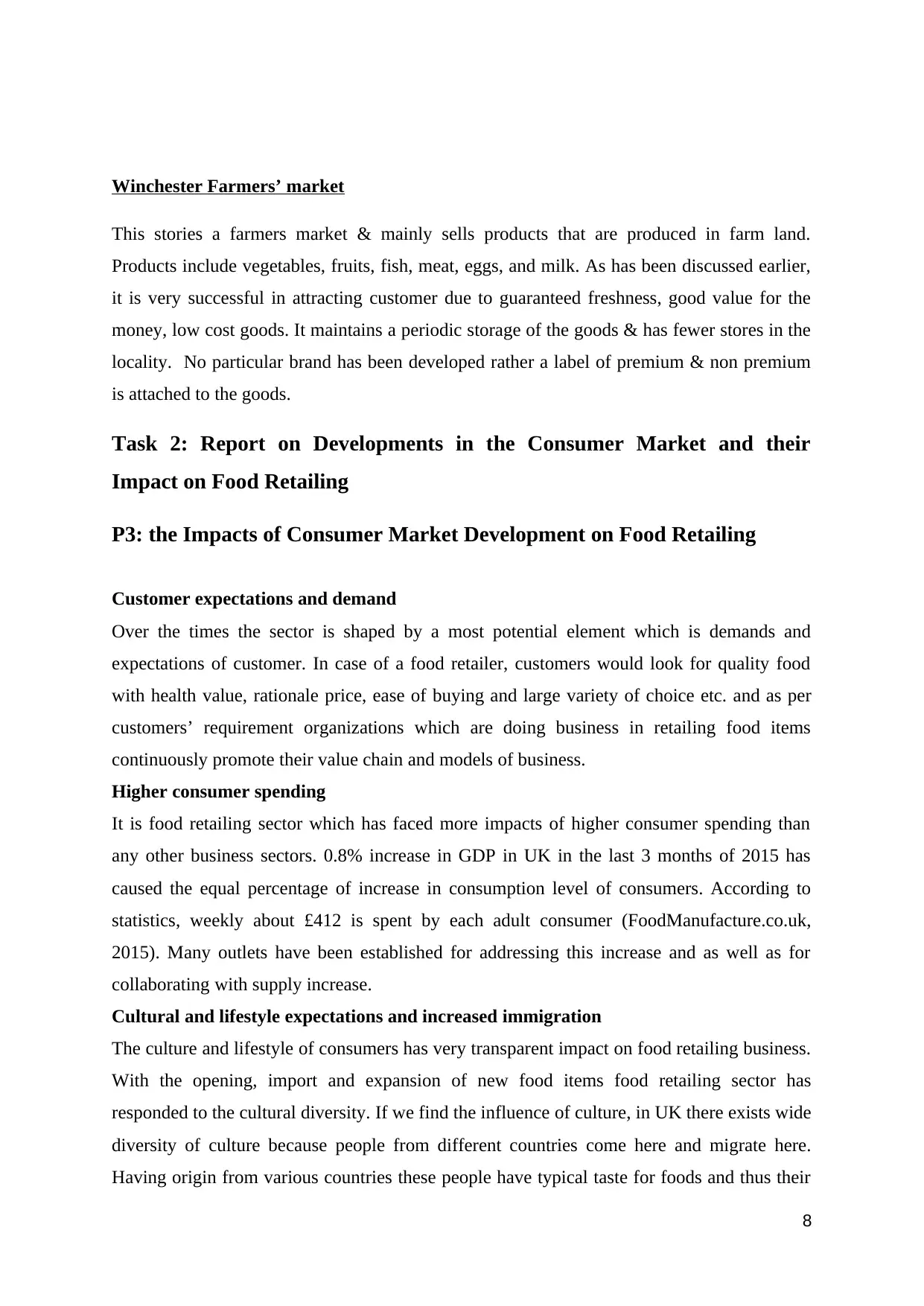
Winchester Farmers’ market
This stories a farmers market & mainly sells products that are produced in farm land.
Products include vegetables, fruits, fish, meat, eggs, and milk. As has been discussed earlier,
it is very successful in attracting customer due to guaranteed freshness, good value for the
money, low cost goods. It maintains a periodic storage of the goods & has fewer stores in the
locality. No particular brand has been developed rather a label of premium & non premium
is attached to the goods.
Task 2: Report on Developments in the Consumer Market and their
Impact on Food Retailing
P3: the Impacts of Consumer Market Development on Food Retailing
Customer expectations and demand
Over the times the sector is shaped by a most potential element which is demands and
expectations of customer. In case of a food retailer, customers would look for quality food
with health value, rationale price, ease of buying and large variety of choice etc. and as per
customers’ requirement organizations which are doing business in retailing food items
continuously promote their value chain and models of business.
Higher consumer spending
It is food retailing sector which has faced more impacts of higher consumer spending than
any other business sectors. 0.8% increase in GDP in UK in the last 3 months of 2015 has
caused the equal percentage of increase in consumption level of consumers. According to
statistics, weekly about £412 is spent by each adult consumer (FoodManufacture.co.uk,
2015). Many outlets have been established for addressing this increase and as well as for
collaborating with supply increase.
Cultural and lifestyle expectations and increased immigration
The culture and lifestyle of consumers has very transparent impact on food retailing business.
With the opening, import and expansion of new food items food retailing sector has
responded to the cultural diversity. If we find the influence of culture, in UK there exists wide
diversity of culture because people from different countries come here and migrate here.
Having origin from various countries these people have typical taste for foods and thus their
8
This stories a farmers market & mainly sells products that are produced in farm land.
Products include vegetables, fruits, fish, meat, eggs, and milk. As has been discussed earlier,
it is very successful in attracting customer due to guaranteed freshness, good value for the
money, low cost goods. It maintains a periodic storage of the goods & has fewer stores in the
locality. No particular brand has been developed rather a label of premium & non premium
is attached to the goods.
Task 2: Report on Developments in the Consumer Market and their
Impact on Food Retailing
P3: the Impacts of Consumer Market Development on Food Retailing
Customer expectations and demand
Over the times the sector is shaped by a most potential element which is demands and
expectations of customer. In case of a food retailer, customers would look for quality food
with health value, rationale price, ease of buying and large variety of choice etc. and as per
customers’ requirement organizations which are doing business in retailing food items
continuously promote their value chain and models of business.
Higher consumer spending
It is food retailing sector which has faced more impacts of higher consumer spending than
any other business sectors. 0.8% increase in GDP in UK in the last 3 months of 2015 has
caused the equal percentage of increase in consumption level of consumers. According to
statistics, weekly about £412 is spent by each adult consumer (FoodManufacture.co.uk,
2015). Many outlets have been established for addressing this increase and as well as for
collaborating with supply increase.
Cultural and lifestyle expectations and increased immigration
The culture and lifestyle of consumers has very transparent impact on food retailing business.
With the opening, import and expansion of new food items food retailing sector has
responded to the cultural diversity. If we find the influence of culture, in UK there exists wide
diversity of culture because people from different countries come here and migrate here.
Having origin from various countries these people have typical taste for foods and thus their
8
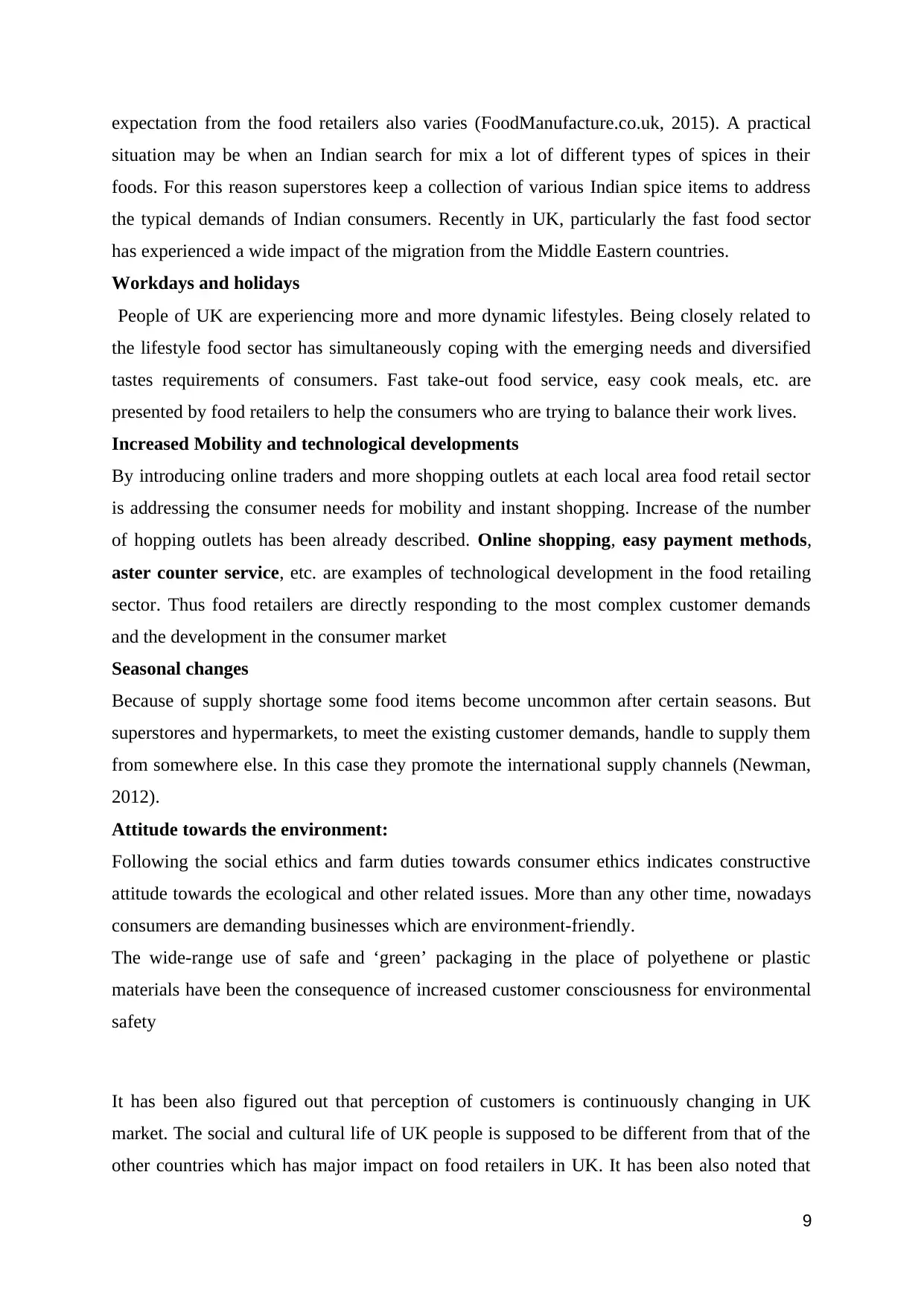
expectation from the food retailers also varies (FoodManufacture.co.uk, 2015). A practical
situation may be when an Indian search for mix a lot of different types of spices in their
foods. For this reason superstores keep a collection of various Indian spice items to address
the typical demands of Indian consumers. Recently in UK, particularly the fast food sector
has experienced a wide impact of the migration from the Middle Eastern countries.
Workdays and holidays
People of UK are experiencing more and more dynamic lifestyles. Being closely related to
the lifestyle food sector has simultaneously coping with the emerging needs and diversified
tastes requirements of consumers. Fast take-out food service, easy cook meals, etc. are
presented by food retailers to help the consumers who are trying to balance their work lives.
Increased Mobility and technological developments
By introducing online traders and more shopping outlets at each local area food retail sector
is addressing the consumer needs for mobility and instant shopping. Increase of the number
of hopping outlets has been already described. Online shopping, easy payment methods,
aster counter service, etc. are examples of technological development in the food retailing
sector. Thus food retailers are directly responding to the most complex customer demands
and the development in the consumer market
Seasonal changes
Because of supply shortage some food items become uncommon after certain seasons. But
superstores and hypermarkets, to meet the existing customer demands, handle to supply them
from somewhere else. In this case they promote the international supply channels (Newman,
2012).
Attitude towards the environment:
Following the social ethics and farm duties towards consumer ethics indicates constructive
attitude towards the ecological and other related issues. More than any other time, nowadays
consumers are demanding businesses which are environment-friendly.
The wide-range use of safe and ‘green’ packaging in the place of polyethene or plastic
materials have been the consequence of increased customer consciousness for environmental
safety
It has been also figured out that perception of customers is continuously changing in UK
market. The social and cultural life of UK people is supposed to be different from that of the
other countries which has major impact on food retailers in UK. It has been also noted that
9
situation may be when an Indian search for mix a lot of different types of spices in their
foods. For this reason superstores keep a collection of various Indian spice items to address
the typical demands of Indian consumers. Recently in UK, particularly the fast food sector
has experienced a wide impact of the migration from the Middle Eastern countries.
Workdays and holidays
People of UK are experiencing more and more dynamic lifestyles. Being closely related to
the lifestyle food sector has simultaneously coping with the emerging needs and diversified
tastes requirements of consumers. Fast take-out food service, easy cook meals, etc. are
presented by food retailers to help the consumers who are trying to balance their work lives.
Increased Mobility and technological developments
By introducing online traders and more shopping outlets at each local area food retail sector
is addressing the consumer needs for mobility and instant shopping. Increase of the number
of hopping outlets has been already described. Online shopping, easy payment methods,
aster counter service, etc. are examples of technological development in the food retailing
sector. Thus food retailers are directly responding to the most complex customer demands
and the development in the consumer market
Seasonal changes
Because of supply shortage some food items become uncommon after certain seasons. But
superstores and hypermarkets, to meet the existing customer demands, handle to supply them
from somewhere else. In this case they promote the international supply channels (Newman,
2012).
Attitude towards the environment:
Following the social ethics and farm duties towards consumer ethics indicates constructive
attitude towards the ecological and other related issues. More than any other time, nowadays
consumers are demanding businesses which are environment-friendly.
The wide-range use of safe and ‘green’ packaging in the place of polyethene or plastic
materials have been the consequence of increased customer consciousness for environmental
safety
It has been also figured out that perception of customers is continuously changing in UK
market. The social and cultural life of UK people is supposed to be different from that of the
other countries which has major impact on food retailers in UK. It has been also noted that
9
⊘ This is a preview!⊘
Do you want full access?
Subscribe today to unlock all pages.

Trusted by 1+ million students worldwide

most of the people in UK prefer to eat low calorie food for keeping their health fit and
healthy. The frequent cultural development has also major impact on the food market of UK.
The attitude and behaviour of UK people is continuously changing and it creates major issues
for most of UK food retailers.
The recent developments in the consumer market have greatly influenced the food retailing
sector of UK. It has brought several timely methods to the business organisations, which have
benefited both the retailers and the consumers. They have also enabled several actions, which
have encouraged the farmers as well in producing more products to sell in the growth
markets. As opined by Seth and Randall (2007, p.28), the in initiatives taken by the retailers
have been proved as a great contribution in the society as well, which have changed the entire
scenario of distribution largely. They have also contributed towards the environment by
enabling several guidelines, such as Climate Change Levies, Town Planning Guidance, and
Sustainability of the Products. The advancement of the technology had also been addressed in
their development measures, which included bar coding, scanning, marketing tools and
loyalty cards.
However, in the contradictory notes of Garcia Martinez et al. (2013, p.1109), the impacts of
consumer market development is not fruitful always. In most of the cases, the recent
development modules of customer development have brought negative impacts to the
consumerism culture of the society. In most of the cases, it is found that the less popular
products are being obsolete from the market quickly, which is highly discouraging for the
competitive growth of the markets.
Task 3: Report on the Importance of Health and Safety Legislation and its
Impact on Food Retailing
P4: Describing the Impacts of Health, Safety and Hygiene Legislation on
the Food Retail Sector
There have always been a wide range of impacts of health, safety and hygiene legislations in
the context of food retail sector. However, the parameter of these impacts has been increased
largely in the recent phase of business. The most relevant laws in the context of food retail
sector of present era are as follows:
Law Description
10
healthy. The frequent cultural development has also major impact on the food market of UK.
The attitude and behaviour of UK people is continuously changing and it creates major issues
for most of UK food retailers.
The recent developments in the consumer market have greatly influenced the food retailing
sector of UK. It has brought several timely methods to the business organisations, which have
benefited both the retailers and the consumers. They have also enabled several actions, which
have encouraged the farmers as well in producing more products to sell in the growth
markets. As opined by Seth and Randall (2007, p.28), the in initiatives taken by the retailers
have been proved as a great contribution in the society as well, which have changed the entire
scenario of distribution largely. They have also contributed towards the environment by
enabling several guidelines, such as Climate Change Levies, Town Planning Guidance, and
Sustainability of the Products. The advancement of the technology had also been addressed in
their development measures, which included bar coding, scanning, marketing tools and
loyalty cards.
However, in the contradictory notes of Garcia Martinez et al. (2013, p.1109), the impacts of
consumer market development is not fruitful always. In most of the cases, the recent
development modules of customer development have brought negative impacts to the
consumerism culture of the society. In most of the cases, it is found that the less popular
products are being obsolete from the market quickly, which is highly discouraging for the
competitive growth of the markets.
Task 3: Report on the Importance of Health and Safety Legislation and its
Impact on Food Retailing
P4: Describing the Impacts of Health, Safety and Hygiene Legislation on
the Food Retail Sector
There have always been a wide range of impacts of health, safety and hygiene legislations in
the context of food retail sector. However, the parameter of these impacts has been increased
largely in the recent phase of business. The most relevant laws in the context of food retail
sector of present era are as follows:
Law Description
10
Paraphrase This Document
Need a fresh take? Get an instant paraphrase of this document with our AI Paraphraser
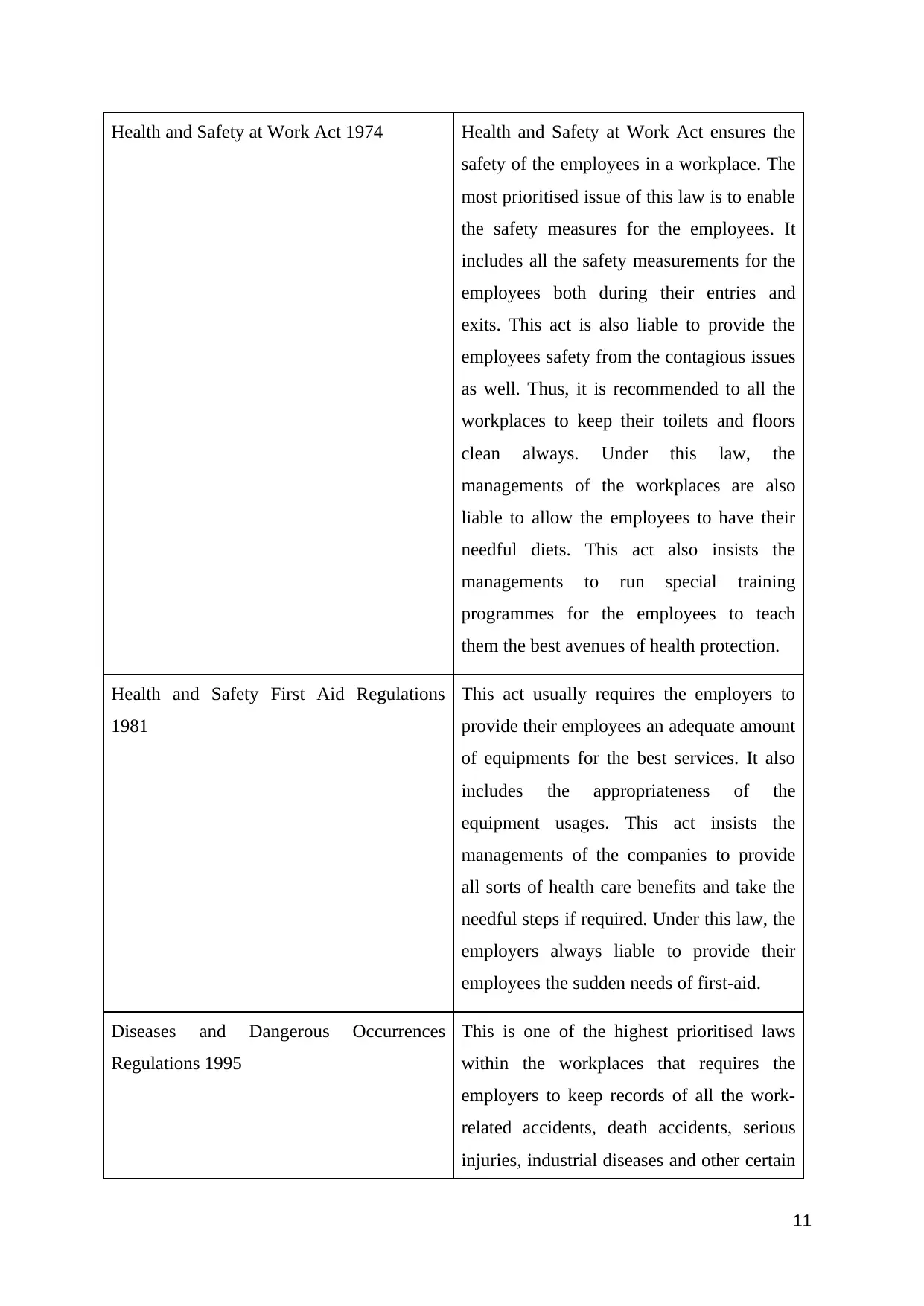
Health and Safety at Work Act 1974 Health and Safety at Work Act ensures the
safety of the employees in a workplace. The
most prioritised issue of this law is to enable
the safety measures for the employees. It
includes all the safety measurements for the
employees both during their entries and
exits. This act is also liable to provide the
employees safety from the contagious issues
as well. Thus, it is recommended to all the
workplaces to keep their toilets and floors
clean always. Under this law, the
managements of the workplaces are also
liable to allow the employees to have their
needful diets. This act also insists the
managements to run special training
programmes for the employees to teach
them the best avenues of health protection.
Health and Safety First Aid Regulations
1981
This act usually requires the employers to
provide their employees an adequate amount
of equipments for the best services. It also
includes the appropriateness of the
equipment usages. This act insists the
managements of the companies to provide
all sorts of health care benefits and take the
needful steps if required. Under this law, the
employers always liable to provide their
employees the sudden needs of first-aid.
Diseases and Dangerous Occurrences
Regulations 1995
This is one of the highest prioritised laws
within the workplaces that requires the
employers to keep records of all the work-
related accidents, death accidents, serious
injuries, industrial diseases and other certain
11
safety of the employees in a workplace. The
most prioritised issue of this law is to enable
the safety measures for the employees. It
includes all the safety measurements for the
employees both during their entries and
exits. This act is also liable to provide the
employees safety from the contagious issues
as well. Thus, it is recommended to all the
workplaces to keep their toilets and floors
clean always. Under this law, the
managements of the workplaces are also
liable to allow the employees to have their
needful diets. This act also insists the
managements to run special training
programmes for the employees to teach
them the best avenues of health protection.
Health and Safety First Aid Regulations
1981
This act usually requires the employers to
provide their employees an adequate amount
of equipments for the best services. It also
includes the appropriateness of the
equipment usages. This act insists the
managements of the companies to provide
all sorts of health care benefits and take the
needful steps if required. Under this law, the
employers always liable to provide their
employees the sudden needs of first-aid.
Diseases and Dangerous Occurrences
Regulations 1995
This is one of the highest prioritised laws
within the workplaces that requires the
employers to keep records of all the work-
related accidents, death accidents, serious
injuries, industrial diseases and other certain
11
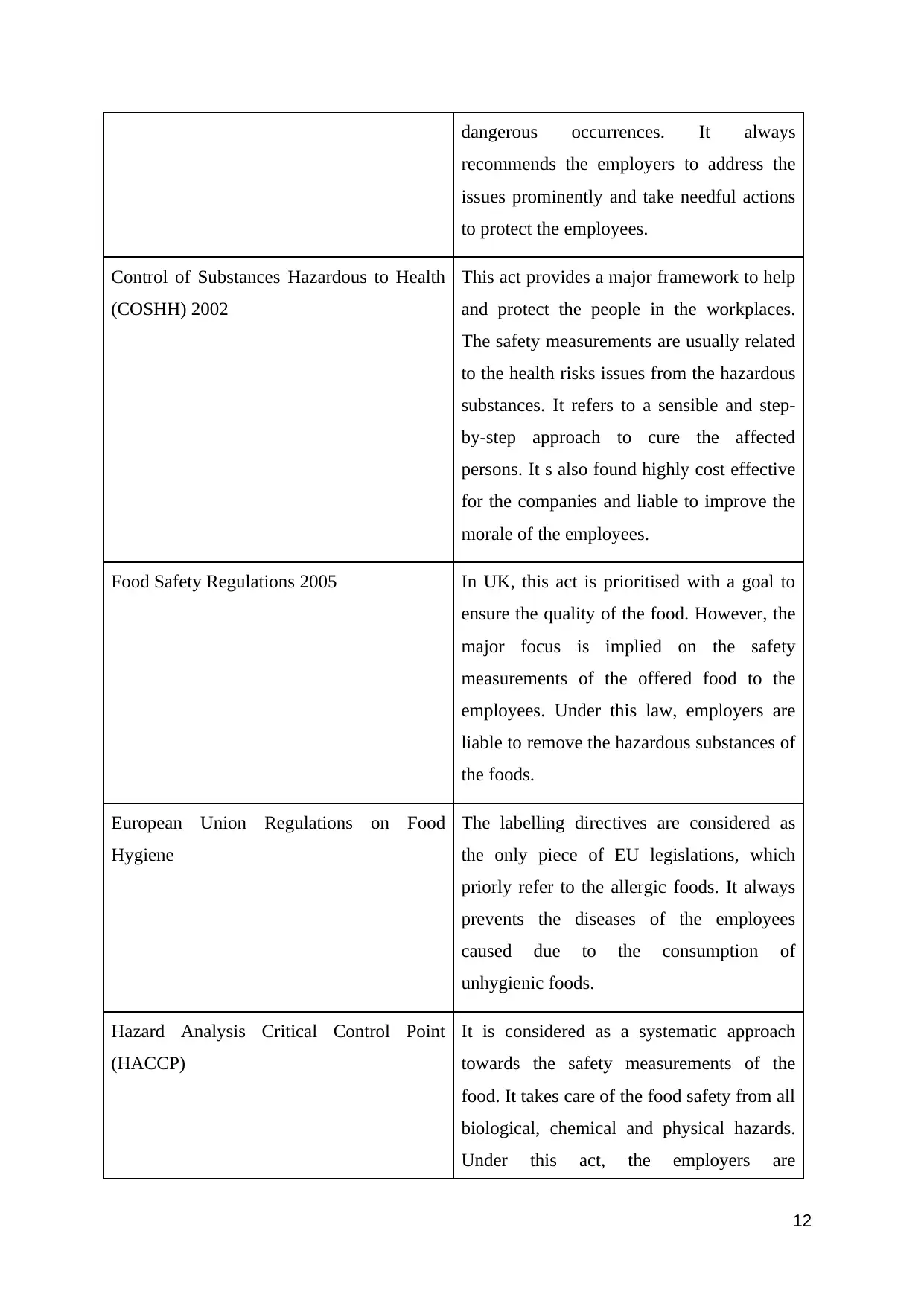
dangerous occurrences. It always
recommends the employers to address the
issues prominently and take needful actions
to protect the employees.
Control of Substances Hazardous to Health
(COSHH) 2002
This act provides a major framework to help
and protect the people in the workplaces.
The safety measurements are usually related
to the health risks issues from the hazardous
substances. It refers to a sensible and step-
by-step approach to cure the affected
persons. It s also found highly cost effective
for the companies and liable to improve the
morale of the employees.
Food Safety Regulations 2005 In UK, this act is prioritised with a goal to
ensure the quality of the food. However, the
major focus is implied on the safety
measurements of the offered food to the
employees. Under this law, employers are
liable to remove the hazardous substances of
the foods.
European Union Regulations on Food
Hygiene
The labelling directives are considered as
the only piece of EU legislations, which
priorly refer to the allergic foods. It always
prevents the diseases of the employees
caused due to the consumption of
unhygienic foods.
Hazard Analysis Critical Control Point
(HACCP)
It is considered as a systematic approach
towards the safety measurements of the
food. It takes care of the food safety from all
biological, chemical and physical hazards.
Under this act, the employers are
12
recommends the employers to address the
issues prominently and take needful actions
to protect the employees.
Control of Substances Hazardous to Health
(COSHH) 2002
This act provides a major framework to help
and protect the people in the workplaces.
The safety measurements are usually related
to the health risks issues from the hazardous
substances. It refers to a sensible and step-
by-step approach to cure the affected
persons. It s also found highly cost effective
for the companies and liable to improve the
morale of the employees.
Food Safety Regulations 2005 In UK, this act is prioritised with a goal to
ensure the quality of the food. However, the
major focus is implied on the safety
measurements of the offered food to the
employees. Under this law, employers are
liable to remove the hazardous substances of
the foods.
European Union Regulations on Food
Hygiene
The labelling directives are considered as
the only piece of EU legislations, which
priorly refer to the allergic foods. It always
prevents the diseases of the employees
caused due to the consumption of
unhygienic foods.
Hazard Analysis Critical Control Point
(HACCP)
It is considered as a systematic approach
towards the safety measurements of the
food. It takes care of the food safety from all
biological, chemical and physical hazards.
Under this act, the employers are
12
⊘ This is a preview!⊘
Do you want full access?
Subscribe today to unlock all pages.

Trusted by 1+ million students worldwide
1 out of 18
Related Documents
Your All-in-One AI-Powered Toolkit for Academic Success.
+13062052269
info@desklib.com
Available 24*7 on WhatsApp / Email
![[object Object]](/_next/static/media/star-bottom.7253800d.svg)
Unlock your academic potential
Copyright © 2020–2025 A2Z Services. All Rights Reserved. Developed and managed by ZUCOL.




